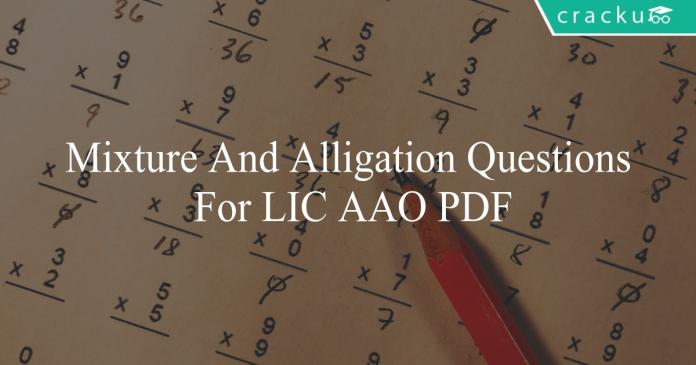Mixture And Alligation Questions For LIC AAO PDF
Download Important Mixture and Alligations questions for LIC AAO exam. Top 20 Mixture and Alligations questions with answers based on previous year asked questions.
Download Mixture And Alligation Questions For LIC AAO PDF
Take a free mock test for LIC AAO
Download LIC AAO Previous Papers PDF
Question 1: In a 120 litre mixture of milk and water, water is only 25%. The milkman sold 20 litres of this mixture and then he added 16.2 litres of pure milk and 3.8 litres of pure water in the remaining mixture. What is the percentage of water in the final mixture?
a) 22
b) 21
c) 24
d) 25
e) 20
Question 2: A vessel was containing 80 litres of pure milk. 16 litres of pure milk was taken out and replaced with equal amount of water. 16 litres of newly formed mixture of water and milk was taken out and then 24 litres of water was added to the mixture. What is the respective ratio between the quantity of milk and water in the final mixture ?
a) 34 : 23
b) 34 : 21
c) 28 : 23
d) 32 : 21
e) 32 : 23
Question 3: Some amount of water is boiling on high heat due to which 20% of the water gets evaporated every hour. At the end of every hour, oil is added to the vessel to make up for the evaporated water. After how many hours will the concentration of oil in the mixture exceed the concentration of water in the mixture for the first time?
a) 3 hours
b) 2 hours
c) 6 hours
d) 5 hours
e) 4 hours
Download LIC AAO Previous Papers PDF
100 Free Computer Awareness Tests for LIC
Question 4: Ramesh has two solutions. In solution A, the ratio of honey and water is 1:4 while in solution B the ratio of honey and water is 2:3. Ramesh wants to prepare a solution in which the ratio of honey and water is 1:3. In what ratio should he mix solutions A and B to get the desired mixture?
a) 3:1
b) 4:3
c) 2:3
d) 5:2
e) 4:1
Question 5: Maneesh has two solutions. In solution A, the ratio of milk and water is 3:2 while in solution B the ratio of milk and water is 9:1. Ramesh wants to prepare a solution in which the ratio of milk and water is 4:1. In what ratio should he mix solutions A and B to get the desired mixture?
a) 3:1
b) 4:3
c) 2:1
d) 5:2
e) 4:1
Question 6: An alloy A contains two metals Aluminium and Gold in the ratio 2 : 3 and an alloy B contains Aluminium and Silver in the ration 4 : 1. If alloy A and B are mixed in the ratio 2 : 1, what is the proportion of Gold in the final mixture?
a) 7/12
b) 2/5
c) 4/15
d) 5/12
e) none of these
Question 7: Alloy A has Iron and Copper in ratio 4:3 (by weight) and Alloy B has Iron and Aluminium in the ratio 2:5. Alloy A and B are mixed in certain ratio such that Iron concentration is 33.33% in the final mixture. Find the ratio (by weight) of Copper and Aluminium in the final mixture.
a) 3:1
b) 3:2
c) 2:3
d) 3:25
e) 1:5
100 Free GK Tests for Insurance Exams
Question 8: A 20 L solution has milk and water in the ratio of 4:1. 4 L is taken out from the mixture and is replaced with water. What is the new ratio of milk and water in the solution?
a) 8:3
b) 4:3
c) 16:9
d) 15:4
e) 25:16
Question 9: Ajay has two different qualities of rice in his shop. The cost price of one is Rs 40 per kg and the cost price of other is Rs 28 per kg. In what ratio should he mix the two qualities, so that by selling the mixture at Rs 42 per kg, he is able to make a profit of 20%?
a) 7:13
b) 4:3
c) 8:13
d) 5:8
e) 7:5
Question 10: Ravi has 2 varieties of wheat. The cost price of the first one is 20 per kg and the cost price of the second one is 28 per kg. In what ratio should he mix the two varieties so that by selling the mixture at Rs 30 per kg, he is able to make a profit of 20%?
a) 5:9
b) 8:3
c) 3:8
d) 4:7
e) 3:5
LIC AAO REASONING QUESTIONS PDF
Question 11: A Milkman sells two types of milk M and N. The water percentage in M is 30% and N is 20%. He want to mix both of them to form a mixture which contains 26% water. In what ratio of M and N should he mix?
a) 2:3
b) 1:2
c) 3:2
d) 2:1
e) 4:5
Question 12: Alloy A contains Iron and Aluminium in the ratio 5:3. Alloy B contains Copper and Iron in the ratio 3:1. If Alloy A and B are mixed in the ratio k:1, resultant mixture has 33.33% copper. Find k.
a) 4/3
b) 3/2
c) 5/4
d) 4/5
e) 2/3
Instructions
A is a mixture of milk and water in the ratio of 1 : 3. There are 80 litres of A. B is a mixture of milk and water in the ratio of 2 : 1. There are 60 litres of B.
Question 13: Which of the following mixtures will yield a 1 : 1 milk to water mixture?
a) 20 litres of A and 40 litres of B
b) 3 litres of A and 4.5 litres of B
c) 50 litres of A and 60 litres of B
d) 40 litres of A and 60 litres of B
e) Both B and D
Question 14: What is the ratio of milk and water if whole of A and B are mixed together?
a) 4:3
b) 7:3
c) 3:7
d) 3:4
e) None of these
Instructions
The following two questions are based on the information given below:
Solution A is a mixture of Alcohol and Cranberry juice in the ratio 3:5. Solution B is a mixture of Alcohol and Orange juice in the ratio 3:2.
Question 15: In what ratio should A and B be mixed such that the concentration of alcohol in the final mixture is 50%?
a) 1:2
b) 2:1
c) 2:3
d) 4:5
e) None of these
Question 16: In what ratio should A and B be mixed such that the concentration of Cranberry Juice and Orange juice in the final mixture is equal?
a) 4:5
b) 3:4
c) 9:16
d) 3:7
e) None of these
Question 17: Alloy A has Gold and Silver in the ratio 5:3 (by weight). Similarly, Alloy B has Silver and Aluminium in the ratio 1:2. The two alloys are mixed in a certain ratio such that the final ratio of Gold and Silver in the final mixture is 3:5. What fraction of the final mixture is Aluminium?
a) 1:2
b) 4:9
c) 3:8
d) 4:7
e) 2:8
Question 18: A solution has milk and water in the ratio 4:3. After adding 300 ml of water the ratio of water and milk becomes 1:1. What was the initial volume of the mixture of milk and water?
a) 1400 ml
b) 2100 ml
c) 3000 ml
d) 3500 ml
e) 2800 ml
Question 19: A solution has milk and water in the ratio 4:3. After adding 300 ml of water the ratio of water and milk becomes 1:1. What was the initial volume of the mixture of milk and water?
a) 1400 ml
b) 2100 ml
c) 3000 ml
d) 3500 ml
e) 2800 ml
Question 20: In a mixture , three liquids A, B and C were in the ratio 3: 5 : 4. 24 litres of this mixture is taken out and 16 litres of liquid A has been added such that quantity of liquid A and liquid B are equal in the newly formed mixture. What was the initial volume of the mixture (in litres) ?
a) 240
b) 90
c) 100
d) 120
e) 150
Question 21: Dish A is made by mixing milk, essence and cream in the ratio 2 : 3 : 4. Dish B is made by mixing milk, essence and cream in the ratio 3 : 4 : 2. When 9 units of Dish A is added to n units of Dish B . If the amount of milk and cream are equal in the new mixture, find the value of n.
a) 2
b) 9
c) 19
d) 18
e) 21
Answers & Solutions:
1) Answer (C)
Mixture = 120 litre, Water = 25%
Quantity of water = $\frac{25}{100} \times 120 = 30$ litre
And milk = 120 – 30 = 90 litre
After selling 20 litre of mixture, remaining mixture = 100 litre
In 100 litre of mixture, amount of milk and water will remain in the same percent.
Water = $\frac{25}{100} \times 100 = 25$ litre
And milk = 100 – 25 = 75 litre
Now, he added 16.2 litre of milk and 3.8 litre of water.
Milk = 75 + 16.2 = 91.2 litre
And water = 25 + 3.8 = 28.8 litre
Total new mixture = 120 litre
$\therefore$ Required % = $\frac{28.8}{120} \times 100 = 24 \%$
2) Answer (E)
Quantity of pure milk in the vessel = 80 litres
After 16 litres of milk is taken out, and replaced with water
=> Milk left = 80 – 16 = 64 litres
Water left = 16 litres
Now, if 16 litres of mixture is taken out, i.e. $(\frac{1}{5})^{th}$ of the mixture
=> Milk left = $64 – \frac{1}{5} \times 64 = 51.2$ litres
Water left = $16 – \frac{1}{5} \times 16 = 12.8$ litres
Now, 24 litres of water is added, quantity of milk will remain unaffected.
=> Milk = 51.2 litres
Water = 12.8 + 24 = 36.8 litres
$\therefore$ Ratio = 51.2 : 36.8 = 32 : 23
3) Answer (E)
In 1 hour, the volume of water gets reduced by 20% or the volume of water becomes 0.8 times of what it was initially. The lost water is replaced by oil. So, as soon as water volume gets lower than 50% of what it was initially, oil concentration will be more than that of water.
Let the initial volume of water be x.
After 1 hour – 0.8x, 2 hours- $0.8^2 =0.64$x, 3 hours- $0.8^3 = 0.512$x
So, after the fourth hour, the volume of water will be definitely less than 0.5x.
Thus, E is the correct answer.
4) Answer (A)
Percentage of honey in solution A= 20
Percentage of honey in solution B = 40
Percentage of Honey in desired mixture = 25%
Let the solutions A and B be mixed in the ratio a:b
then
20a + 40b = 25(a + b)
=> 15b = 5a
=> a/b = 3
Hence the required ratio in which A and B has to be mixed is 3:1
5) Answer (C)
Percentage of milk in solution A= 60
Percentage of milk in solution B = 90
Percentage of milk in desired mixture = 80
Let the solutions A and B be mixed in the ratio a:b
then
60a + 90b = 80(a + b)
=> 10b = 20a
=> a/b = 3
Hence the required ratio in which A and B has to be mixed is 2:1
6) Answer (B)
Let there be 10 kg of Alloy A and 5 kg of alloy B
The amount of Gold in alloy A = 3/5 of 10 = 6 kg
Thus, the proportion of Gold in the final mixture = 6/15 = 2/5
7) Answer (D)
Let us assume that we mixed 7x Alloy A with 7y alloy B.
=> Total Iron in the final mixture will be 4x+2y which is 33.33% or 1/3 of the whole mixture.
=> $\frac{4x+2y}{7x+7y} = \frac{1}{3}$ solving which we get 12x+6y=7x+7y or 5x=y
Now, Copper in the mixture will be 3x and Aluminium will be 5y
So, the required ratio is 3x/5y = 3/25
8) Answer (C)
20 L solution has milk and water in the ratio 4:1.
So milk and water are 16 L and 4 L respectively.
Now 4 L is removed.
So 0.8 L of water are removed and 3.2 litres of milk are removed.
After the removal, the 16 litres of the solution contain 12.8 litres of milk and 3.2 litres of water.
Now 4 litres of water are added. Hence, the final composition will be 12.8 litres of milk and 7.2 litres of water.
So, the required ratio will be 12.8 : 7.2 = 16:9
9) Answer (E)
Ajay wants to make a profit of 20% by selling at 42 per kg.
Hence the cost price of the mixture should be 42*.8 = 35 per kg.
Let the ratio in which 40 kg and 28 kg rice are mixed is a:b, then
40*a + 28*b = 35*(a + b)
=> 40a + 28b = 35a + 35b
=> 5a = 7b
=> a/b = 7:5
Hence option E is the correct answer.
10) Answer (E)
Since the shopkeeper wants to earn a profit of 20% by selling the mixture at 30, the cost price would be 30/1.2 = 25.
Now let the required ratio be a:b then we have
20a + 28b = 25(a + b)
3b = 5a
a/b = 3:5
Hence the required ratio is 3:5
11) Answer (C)
Let the quantities of M and N be m and n.
30% of M + 20% of N = 26% of (M+N)
30m+20n = 26(m+n)
4m = 6n
m:n = 3:2
12) Answer (C)
If we take 8 units of A, we have 5 units of Iron and 3 units of Aluminium.
Similarly, if we take 4 units of B, we have 3 units of Copper and 1 unit of Iron.
Let us take k units of A and 1 unit of B.
=> Total units = k+1
Total Copper units = 3/4
=> (3/4)/(k+1) = 1/3
=> 9 = 4k + 4 or k = 5/4
13) Answer (E)
Let there be x litres of A, and y litres of B.
X litres of A will have $\frac{x}{4}$ litres of milk and y litres of B will have $\frac{2y}{3}$ litres of milk.
To get a 1:1 solution of milk and water, the ratio of milk to the total should be 1:2.
Therefore,
$\frac{\frac{x}{4}+ \frac{2y}{3}}{x+y} = \frac{1}{2}$
$\frac{x}{y} = \frac{2}{3}$
There A and B have to be added in the ratio of 2:3.
Option B and D satisfy.
14) Answer (D)
80 litres of A will have 20 litres of milk and 60 litres of water. 60 litres of B will have 40 litres of milk and 20 litres of water.
After mixing ratio of milk and water will be 60:80 = 3:4
Hence, option d
15) Answer (D)
Let us assume that we take 8x of A and 5y of B.
8x of A contains 3x alcohol and 5x Cranberry juice. Similarly, 5y of B contains 3y alcohol and 2y juice.
So, 3x+3y is 50% of 8x+5y
=> 6x+6y = 8x+5y => y = 2x
Thus, the ratio will be 8x/5y = 8/10 = 4:5
16) Answer (E)
Let us assume that we take 8x of A and 5y of B.
8x of A contains 3x alcohol and 5x Cranberry juice. Similarly, 5y of B contains 3y alcohol and 2y juice.
Now, 5x = 2y or x/y = 2/5
So, required ratio is 8x/5y = 16/25
17) Answer (B)
Let us assume that we mix 8x of A with 3y of B
So, 8x of A has 5x Gold and 3x Silver while 3y of B has y Silver and 2y Aluminium.
We are given that Gold:Silver in the final mixture is 3:5
=> 5x/3x+y = 3/5 or 25x = 9x+3y
=> 16x = 3y
Now, Aluminium is 2y out of 8x+3y mixture.
=> Ratio is 2y/(8x+3y) = 2y/(24x) = y/12x = 16/(12X3) = 4:9
18) Answer (B)
Let the initial volume of the mixture be 7V
Amount of milk in the mixture = 4V
Amount of water in the mixture = 3V
After adding 300 ml of water the ratio becomes 1:1. So we get,
4V = 3V + 300
V = 300 ml
Total volume of the initial mixture = 7*300 = 2100 ml
Hence Option B.
19) Answer (B)
Let the initial volume of the mixture be 7V
Amount of milk in the mixture = 4V
Amount of water in the mixture = 3V
After adding 300 ml of water the ratio becomes 1:1. So we get,
4V = 3V + 300
V = 300 ml
Total volume of the initial mixture = 7*300 = 2100 ml
Hence Option B.
20) Answer (D)
Let the quantity of A,B and C in original liquid be 3k, 4k and 5k
When 24 litres has been taken out, the quantity of A,B and C becomes (3k – 6), (5k – 10) and (4k – 8)
Now, when 16 litres of A was added in the mixture => Quantity of A => (3k + 10)
=> 3k + 10 = 5k – 10
=> k = 10
Initial volume of liquid was ( 3k + 4k + 5k ) = 12k = 120 litres
Hence, option D is correct
21) Answer (D)
9 units of Dish A contains 2 units of milk, 3 unit of essence and 4 units of cream.
When n units of B is added to 9 units of A, the mixture will contain
$2 + \frac{3n}{9}$ units of milk, $3 + \frac{4n}{9}$ units of essence and $4 + \frac{2n}{9}$ units of cream.
Given,
$2 + \frac{3n}{9}$ = $4 + \frac{2n}{9}$
n = 18





